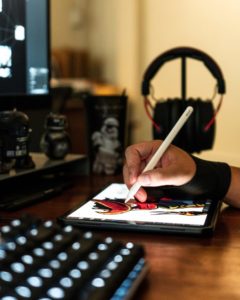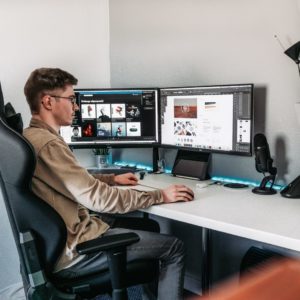The world of photo manipulation and graphic design has seen many improvements over the last 20 years. With the onset of the internet age, digital marketing and more advanced manipulation software has come to the fore. No software has exemplified that need quite so well as Adobe’s Photoshop.
What is Photoshop?
Photoshop is one of the best known tools for graphic design.
Ian Peterman, CEO Tweet
Created in 1990, Photoshop is the leading photo manipulation software in the world.

This is thanks in part to its wide availability to users, its necessity in many job sectors and the plethora of free learning resources available for novice designers who want to improve their graphic design and editing skills.
And that’s really at the heart of the tool’s rise from obscure tech to having a near monopoly in the design sector, along with the other programs in the Adobe Creative Suite.
The ability to use Photoshop is no longer a niche skill exclusive to the most skilled designers and marketing teams. It’s now widely available to anyone who can pay the monthly subscription, although there exists a small sector of designers who have been put off by Photoshop’s divergence from a pay-once lifetime fee to a tool that requires a monthly subscription.
How much is does Photoshop cost?

The price range for a monthly Photoshop subscription is usually around $9.99/month.
The affordable fee is likely because of Photoshop’s primary user base: freelancers. Because freelance graphic designers rely on commissions to make an income, projecting steady monthly revenue becomes difficult.
That said, Adobe has tried to make accommodations by creating bundle packages with its other programs in the Creative Suite to better accommodate the need of designers, editors and producers who might otherwise fork out for multiple Adobe products.
Rather conveniently for those designers who aren’t quite sure if they’re ready to commit to a monthly subscription for the program, Adobe does offer every single user a 30-day free trial to test out the software and familiarize themselves with it.
When is Photoshop used?
Photoshop is a great tool to use when working with images that aren't vector graphics.
Ian Peterman, CEO Tweet
Here’s the thing: Photoshop is used everywhere, all the time, for everything. Most posters, billboards, magazines, online ads and apparel designs are created through Photoshop. The program gives users unparalleled flexibility and power through its layer structure.

The layer structure simply means that images in Photoshop exist slightly differently than they do in physical marketing resources. Rather than a single image printed as one layer, Photoshop stores and manipulates different parts of the image as separate layers.
The background is its own layer, as is each individual text box, texture, and design element you could think of putting in your marketing campaign. The genius of this isn’t just limited to users being able to manipulate separate parts of the same image, however.
For the more skilled designer, Photoshop offers options to group and merge layers as needed to create a smoother experience. Many top-level designers will work with layers that reach into the hundreds, making it ever more important to provide them with the functionality to keep things neat and efficient.
The Photoshop community is also a big reason behind the software’s success. As the most widely used digital manipulation software on the market, there exist many YouTube channels and blogs purely dedicated to teaching people how to use the software. These tutorials range from helping novices come to grips with the basic tools given to them to mammoth side-by-side projects where viewers can follow along to create a masterpiece they otherwise would never have known how to bring to life.
As far as digital manipulation software goes, Photoshop has been going strong for 30 years… and it doesn’t look like it’s slowing down any time soon.
Your Next Steps
Related Conscious Design BLOG Posts
What’s a Feasibility Study?
A feasibility study is a very important step in making sure a product will be successful. I break down what they are and why they matter.
What it Takes to Develop a Smart Product
As the Internet of Things has grown over the years, smart products have become a pretty hot item. Many people have product ideas for turning a “dumb” product into a “smart” one. It’s great, I love that we are improving our tools and gadgets in so many new and interesting ways. Technology is something that amazes me, and will probably continue to do so for the rest of my life. For a lot of people, it might seem like a fairly simple task to just add some electronics to a product and make it smart. You should understand what you or your business will need to developing such a product. You might have gotten an idea about what it really takes in our post a couple weeks ago Time, Budgets, & Luxury, but I’d like to dive more into exactly what it takes to create a smart product. There is a lot of time and effort that is beyond what low-tech products need to become a reality. For us, “smart” is anything that contains electronics that can connect to other electronics, so wi-fi, Bluetooth, NFC, USB, etc, usually there are sensors or other input points that collect data to be shared with other devices. Putting a motor into a mower doesn’t make it “smart”. Putting a computer on board with internet access, connected to an app would make it “smart”. A “smart” product doesn’t always have to touch the internet either, there are many closed circuit smart devices. IOT (internet of things) products MUST touch the internet however. In no particular order, here is a breakdown of everything that goes into developing a “smart” product. This will give you an idea of what you can expect if you choose to dive into this process. Disciplines required Most “dumb” products can get away with just an Industrial Designer or Mechanical Engineer. Both work, but you can read more about the differences in our post3 Things You Should Know About Designers & Engineers. No electronics means no coders, no electrical engineers, and many others. If you are working with basic electronics, such as motors, switches, etc, you can sometimes avoid getting an electronics person involved. BLANK Ian Peterman, CEO Tweet There are many mechanical side people who can make that happen. Now, if we’re creating a “smart” product, we will need these: App Design & Development Electronics Design Electrical Manufacturing Web Design & Development There are possibly a few others depending on how big you go, such as database development, but these areas would cover most of the work needed to get the project done. Time It can easily double the amount of time to design and develop a new product by adding in electronics that would make a product “smart”. Does this mean it would take longer on a calendar? Not necessarily. When we can, we prefer to do side-by-side development of the mechanical and electrical. This ensures both sides work together and keeps the timeline shorter. The collaboration between mechanical and electrical can really build some synergy with the project. The result is that issues can be caught earlier, avoiding them from popping up super late in the process where it’s harder and more expensive to fix. Cost BLANK Ian Peterman, CEO Tweet Double the time, at least double the cost. Electronics are usually more expensive to prototype. The benefit is the manufacturing on the back end makes super components, even fully custom ones. These products also sell for a higher premium than their “dumb” counter parts. Planning Working on more complex projects such as this involves a lot more planning and project management. Here at the Peterman Design Firm, that is one of our core competencies. You need to make sure the firm you work with has experienced Project Managers on its team. They also need to be able to handle the load required to bring such a product to life. BLANK Ian Peterman, CEO Tweet Network We’ve talked about how important your network is in our last post Building Your Network for Success. This is a place where it really matters as you need so many resources to get the project completed. If you are working with some of the very large and expensive firms out there, they probably have such a large in-house team they can handle most things, but you pay for it. Medium sized firms often still have the network and don’t do everything in-house. Small ones and freelancers don’t always have the network you need and are often still building them. The caveat of course is if they have been in business for 20 plus years, they probably have a good network. Feasibility Study BLANK Ian Peterman, CEO Tweet I put this here just because people like to skim, and this is a key part. Feasibility studies should never be skipped with products in this category. A feasibility study is very important to do at the beginning of your project. The firm you choose to use should be able to offer this service by itself. Don’t commit to full development until you know it can be done. A complete feasibility study from the Peterman Design Firm will give you cost expectations for the entire project, time frame, potential issues, project duration estimation and breakdown, and some market information on competitors. If you’d like to learn more about feasibility studies, check out our post What’s a Feasibility Study? When you have a great idea for a “smart” product, it’s at least worth getting a consultation on the idea. If your budget can handle it, a feasibility study would be valuable. Then if it looks good, invest the money. The great thing with “smart” products is that they are in high demand. Plus we seem to be on an exponential growth with them. For now, it’s a trend I feel will stay with us for a while, if not permanently. Your Next Steps Developing Smart Products What does it take to develop a smart product?
5 Tips for Market Research & Analysis
Wondering about Market Research & Analysis? This will give you a few tips on what it is and how to start your own research.


